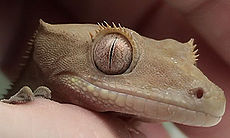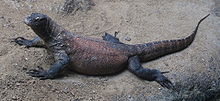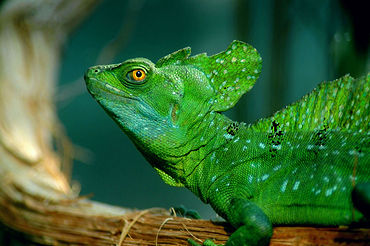- Portal: Amphibians and Reptiles
-
- Wikipedia portals:
- Culture
- Geography
- Health
- History
- Mathematics
- Natural sciences
- People
- Philosophy
- Religion
- Society
- Technology
The Amphibians and Reptiles Portal
Amphibians (class Amphibia; from Greek αμφις "both" and βιος "life") are a taxon of animals that include all living tetrapods (four-legged vertebrates) that do not have amniotic eggs, are ectotherms, and generally spend part of their time on land. Most amphibians do not have the adaptations to an entirely terrestrial existence. There are around 6,000 described, living species of amphibians.
Reptiles (Reptilia; from Latin repere, "to creep") are tetrapods and amniotes, animals whose embryos are surrounded by an amniotic membrane. Today they are represented by four surviving orders: Crocodilia (crocodiles, caimans and alligators), Sphenodontia (tuatara), Squamata (lizards, snakes and amphisbaenids), and Testudines (turtles). Reptiles inhabit every continent except for Antarctica, although their main distribution comprises the tropics and subtropics.
Herpetology (Greek ἑρπετόν herpeton "to creep" and λόγος logos "explanation") is the branch of zoology concerned with the study of reptiles and amphibians.
Selected article of the month
The Komodo dragon (Varanus komodoensis), also known as the Komodo Monitor, Komodo Island Monitor, Ora (to the natives of Komodo), or simply Komodo, is a species of lizard which inhabits the islands of Komodo, Rinca, Flores, Gili Motang, and Gili Dasami in central Indonesia.A member of the monitor lizard family Varanidae, and the clade Toxicofera, the Komodo is the largest living species of lizard, growing to an average length of 2–3 metres (6.6–9.8 ft). This great length is attributed to island gigantism, as there are no carnivorous mammals to fill the niche in the islands that they live on, and the Komodo dragon's low metabolic rate. As a result of their great size, these lizards are apex predators, dominating the ecosystems in which they live.
Komodo dragons were only discovered by Western scientists in 1910. Their large size and fearsome reputation makes them popular zoo exhibits. In the wild their range has contracted due to human activities and they are listed as vulnerable by the IUCN. They are protected under Indonesian law and a national park, Komodo National Park, was founded in order to protect them.
Selected picture of the month
The plumed basilisk (Basiliscus plumifrons) is a species of lizard native to Latin America. They are omnivorous and will eat insects, small mammals (such as rodents), smaller species of lizards, fruits and flowers.
Did you know...
-
...that Four-Inch Regulation refers to a regulation passed by the U.S. Food and Drug Administration in 1975 outlawing the sale of turtles with a carapace length of less than four inches to cope with "the public health impact of turtle-associated salmonellosis"?
-
...that tuatara feature in a number of indigenous legends, and are held as ariki (God forms). Tuatara are regarded as the messengers of Whiro, the god of death and disaster, and Māori women are forbidden to eat them?
-
...that the once-abundant golden toad (Bufo periglenes), often featured on posters promoting the biodiversity of Costa Rica, have not been seen since 1989?
-
...that the hatchlings of the egg-laying East African Boulengerula taitanus, a caecilian, have special teeth that allow them to peel and eat their mother's skin which contains a high level of fat and other nutrients?
Amphibians and Reptiles Categories
Tetrapods • Amphibians • Frogs • Salamanders • Reptiles • Crocodiles • Lizards • Snakes • Turtles • Reptiles by geography • Herpetology Amphibians and Reptiles Lists
WikiProject
WikiProject Amphibians and Reptiles Topics about Amphibians and Reptiles
Things you can do
As organized by WikiProject Amphibians and Reptiles, the current tasks are:
- Create article for each Order and Family
- Ensure all Family articles are taxonomically consistent
- Ensure all articles between Order and Family rank are taxonomically consistent
- Create article for each Genus
- Ensure all articles between Family and Genus rank are taxonomically consistent
- Create articles for all Species
- Create links for all species articles on appropriate articles
- Create lists of uncreated articles to add to category pages:
- List of amphibians
- List of reptiles
- Prehistoric amphibian
- Create articles for aspects of amphibian and reptile biology, such as snake scales and vocal sac.
- Copyedit current article text to coincide with Wikipedia:Naming conventions (fauna) (e.g., convert "Coral Snake" to "coral snake").
- For articles with {{AARTalk}} templates, rank and assess articles that have not been given a rating or an importance rating (see Category:Unassessed_amphibian_and_reptile_articles).
- Find images for Category:Amphibian and reptile articles needing photos
Categories:- Amphibians and reptiles portal
- Science portals
- Amphibians
- Reptiles
- Herpetology
Wikimedia Foundation. 2010.





